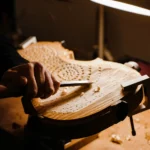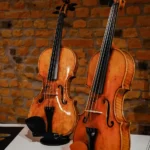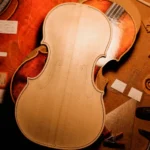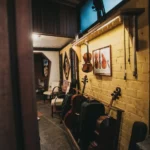Exploring del Gesu’s Violins: Let’s take a look at the Guarneri’s history
Back to BlogMost of violin history comes from the families of the great Master Makers, they made history in the development of this instrument!
The Guarneri Family was one of them, and their long tradition of violin-makers made important changes in the instrument.
The first was Andrea (c. 1626–98), who probably worked with Stradivari in the workshop of Nicolò Amati (son of Girolamo). His son Giuseppe (1666–c. 1739) at first made instruments like his father’s but later made them in a style of his own, with a narrow waist; his son Pietro of Venice (1695–1762) was also a fine maker, he brought the Cremonense style of work to the makers in Venice. Another son of Andrea, Pietro Guarneri (1655–c. 1728), moved from Cremona to Mantua, where he made violins that varied considerably from those of the other Guarneris…
And it goes on and on. We all know the name Giuseppe Guarneri del Gesù. After all, he was the member of the family that really made a name as a violin maker. But each member had an important role.
Let’s meet the Guarneri Family
Andrea Guarneri
Andrea Guarneri (Cremona, Italy, 1626-98), founder of the family, was a fellow apprentice of Stradivari in the workshop of Nicolo Amati. Approximately 250 violins, 4 violas, and 14 violoncellos by him are thought to exist.
He worked with Amati until 1698, and many of his violins followed the small Nicolò pattern. In general Guarneri’s work is somewhat freer and less exacting than Amati’s, but nonetheless of superb quality. His contralto violas in particular, of which about eight survive, are regarded as some of the best in existence.
Pietro Guarneri
Pietro Giovanni Guarneri, born in Cremona in 1655, was the elder son of Andrea. Known as Peter Guarnerius of Mantua, he worked there from 1680 until his death in 1720. His violins are esteemed but not numerous.
Giuseppe Guarneri
Giuseppe Giovanni Battista Guarneri (1666-1739 or 1740), known as Joseph Guarnerius filius Andreae, was the second son of Andrea. He made possibly as many violins as his father and a few more violoncellos. No violas are known. His work is overshadowed by that of other family members.
According to Tarisio’s info, in the family tradition, the sons of Giuseppe Guarneri began assisting their father around 1710.
Pietro Guarneri
Known as Peter Guarnerius of Venice (1695-1762), he was the older brother of Joseph Guarnerius del Gesu. Pietro did not stay in Cremona, at that time violin making in the city was dominated almost exclusively by the Stradivari family, which made doing business more difficult, making him move to Venice. He worked with his uncle Pietro in Mantua and then in his own workshop in Venice until his death.
Following del Gesù, he is the other big star of the family. The grain of his bellies is often wide, the distance between the F-holes is conspicuous, the F-holes themselves are rounder and less Brescian, the scrolls are beautifully cut and the varnish is superb, from its golden tints to its pale red.
Giuseppe Guarneri del Gesù
The illustrious member of the family was Bartolomeo Giuseppe Guarneri (Cremona, Italy, 1698-1744), the fifth and last member of the family, grandson of Andrea, son of Giuseppe Giovanni Battista. The addition of “del Gesu” to the name is due to the Greek abbreviation for Jesus (IHS) beneath a cross on the labels indicate veneration for the Holy Name.
Approximately 150-250 of his violins are known to exist, and some violas and at least one violoncello are attributed to him.
The stunning and daring style of Guarneri impresses anyone
Guarneri’s work was rougher in design but much more adventurous with a great expression of artistic and experimental nature. As a result of his studies, after analyzing Amati’s pattern and sound of the time he noticed there was a request for a more powerful sound. Therefore he looked for inspiration in the Brescian models.
The outline of his violins is found on the instruments of Antonio Stradivari. Modeling of the back and table are noticeably flattened, seemingly inspired by Maggini. The F-holes are usually elongated, more open, and less refined. With Brescian looking sound-holes set low down, the rich, almost too profusely rich, varnish, and fine wood, give these violins quite a characteristic appearance.
It seems Guarneri’s creativity and daring in design and construction more than compensated for his corresponding lack of interest in the details of the workmanship.
Unfortunately, a del Gesù is more difficult to find than a Strad. His output, as compared to Stradivari, is one to six. His life and career were shorter. His most famous work was Il Cannone, impressively attractive, of a majestic and austere charm. It was owned by the illustrious violinist Paganini of the 19th Century. Known to him affectionately as “my cannon violin” for its powerful sound.
Let s have a look at the works from the makers of Mio Cannone inspired by this fantastic family – Guarneri.
VIOLIN BY LUIZ AMORIM, CREMONA, 2021
COPY OF JOSEPH GUARNERI “DEL GESÙ” CANNONE, 1743
“Named by its ex-owner, the illustrious Nicolo Paganini, this violin is known because of its power and resonant sound. This instrument is covered by a luminous reddish-brown varnish. Scratches and signs of wear accentuate the original’s evidence of time and playing. Some very distinct characteristics of this masterpiece are somewhat the high sides, the imponent scroll, and a considerably curved neck. ”Il Cannone” ranks as the greatest masterpiece of this inspired maker.” Luiz Amorim
VIOLIN BY LUIZ AMORIM, CREMONA, 2021
COPY OF JOSEPH GUARNERI “DEL GESÙ” SAINTON, 1744
“Alongside with Ole Bull, its bold form highlights Guarneri’s late work; its strong work shows the typical identity of ”del Gesù”. According to Biddulph, Sainton is a master violin giving the impression of a hurried maker trying to complete his final instrument while attempting to achieve a convincing acoustical and stylistic result. A pronounced kink to the lower curved of the c-bouts, especially visible from the bass side is a typical style of Guarneri’s last works. The carving of its head and F-holes are even more hurried and shaky than the others from the same period. The Fs lean towards each other and the purfling cut and finish confirm ”del Gesù’s” exceptional work. This violin highlights his freedom of expression, as in his final works each head seems to be different from any other.” Luiz Amorim
VIOLIN BY LUIZ AMORIM, CREMONA, 2021
COPY OF JOSEPH GUARNERI “DEL GESÙ” CESSOLE, 1736
“Each one of Guarneri’s instruments is a new experiment; he shows a continuous development, always searching for something better. This violin highlights his way of work, with an appearance of delicacy, commonly not expected from ”del Gesù.
⠀
The arching becomes fuller, and the sound holes are set higher; the edges and corners are somewhat delicate and refined – a constant characteristic of Guarneri’s middle period. Like others from this period, the head was made by his father Giuseppe Guarneri ”Filius Andrea”, whose heads are recognizable by the delicate and uniform symmetry of the volute. The body of the violin is a little small, a few millimeters shorter than a standard Stradivari.” Luiz Amorim
VIOLIN BY LUIZ AMORIM, CREMONA, 2021
COPY OF JOSEPH GUARNERI “DEL GESÙ”OLE BULL, 1744
“Considered to be one of the last works of ”del Gesù” and named after a former owner, the famous Norwegian violinist, Ole Bull (1810-1880), this violin was his most esteemed one. Its unique and exceptional design is believed to be “Guarneri’s most characteristic masterpiece” (The Hill Company). According to Peter Biddulph, the violin features the reconciliation of dark Brescian sonority with the quality and richness of the Cremonese tradition.” Luiz Amorim
VIOLIN BY LUIZ AMORIM, CREMONA, 2021
COPY OF JOSEPH GUARNERI “DEL GESÙ” CARRODUS, 1743
“Made in 1743, just one year before ”del Gesù’s” tragically early death. The Carrodus is considered to be in the list of Guarneri’s most spectacular violins, it is a fine companion to Il Cannone; they share distinctive features, mainly its powerful appearance, exalting ”del Gesù’s” most imaginative and creative epoch. The soundholes are unique, asymmetrical, and more elongated, typically of Guarneri’s late work. Its arching shows a bit of influence of the Brescia school and it’s fuller than others from the same year. The scroll’s bold and robust appearance, just like Il Cannone, imprints ”del Gesù’s” expressive work.” Luiz Amorim
VIOLIN BY GAIAN AMORIM, CURITIBA, 2017
GUARNERI MODEL
“My idea on making this instrument was to capture the essence of the original and summarize its most captivating features, like the unusual figure of the back and sides, the design of the scroll, and the beautiful golden-brown varnish. Creating an old patina and leaving some specific tool marks are details that also represent the incredible work of ‘del Gesù.’
After hearing “Il Cannone” amazing sound, Napoleon commissioned Paganini to find a similar instrument. The 1738 Guarneri ‘del Gesù’ the ‘Kemp, Emperor,’ named after him, was then found by Paganini and given to General Ernouf, Napoleon’s assistant. Other than sound, this violin has similar thicknesses of the back and the overall preservation of Paganini’s Cannone.” Gaian Amorim









